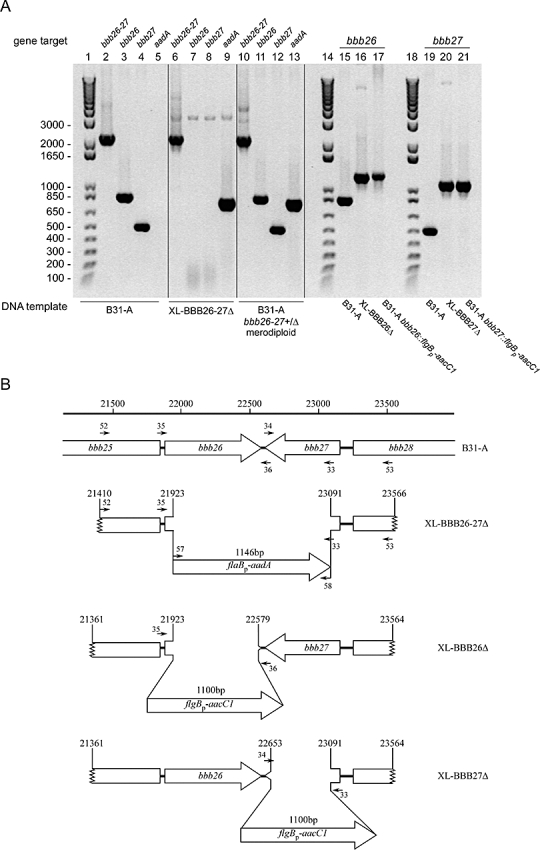Fig. 2.

A. PCR analysis of genomic DNA from B. burgdorferi clones transformed with gene inactivation constructs targeting genes in the bbb26–27 region. Template DNAs from transformants are identified below the lanes and PCR amplification targets above the lanes. Template DNA from B31-A illustrates the PCR products from the wild-type alleles of bbb26–27, bbb26 and bbb27 (lanes 2–5, 15 and 19), whereas template DNAs from the gene inactivation constructs (XL-BBB26–27Δ, XL-BBB26Δ and XL-BBB27Δ) depict the PCR profiles of the mutated alleles (lanes 6–9, 16 and 20). The PCR products resulting from the clones transformed with the allelic exchange inactivation plasmids are illustrated in lanes 10–13, 17 and 21. The 1 kbp-plus size standards (Invitrogen) were run in lanes 1, 14 and 18 and sizes (base pairs) are indicated to the left of the panel. B. Graphical representation of the bbb26–27 region on cp26 (B31-A) and the cloned pieces of DNA used for the allelic exchange constructs (XL-BBB26–27Δ, XL-BBB26Δ and XL-BBB27Δ). The 1168 bp region of cp26 between nucleotides 21923 and 23091 was replaced with the 1146 bp flaBp–aadA resistance cassette to create XL-BBB26–27Δ for disruption of both bbb26 and bbb27. The 742 bp region of cp26 between nucleotides 21923 and 22579 was replaced with the 1100 bp flgBp–aacC1 resistance cassette to create XL-BBB26Δ for disruption of bbb26. The 438 bp region of cp26 between nucleotides 22653 and 23091 was replaced with the 1100 bp flgBp–aacC1 resistance cassette to create XL-BBB27Δ for disruption of bbb27. Locations of the primers used for analysis in (A) are indicated and the sequences are listed in Table S1.
